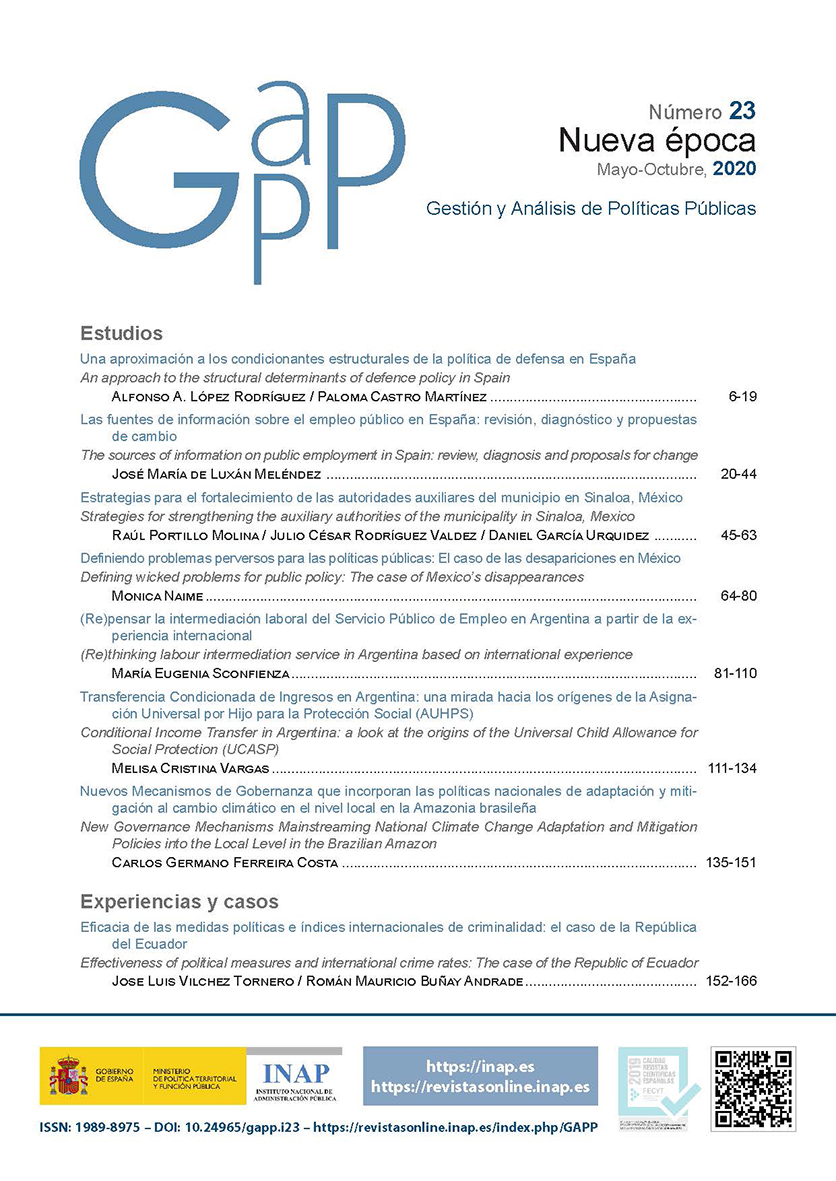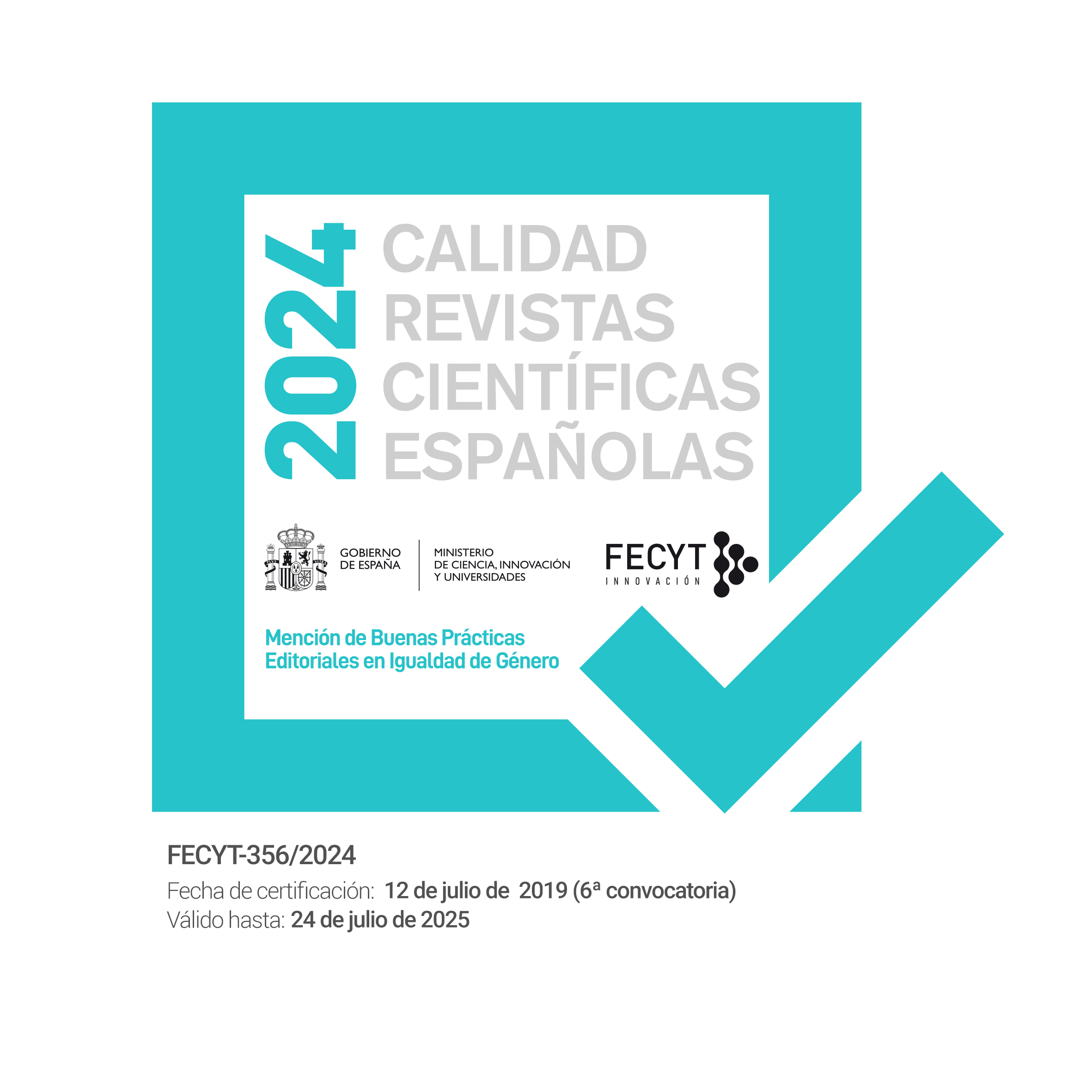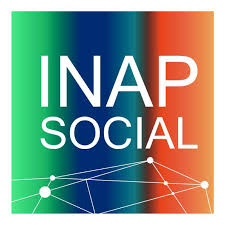Effectiveness of political measures and international crime rates: The case of the Republic of Ecuador
DOI:
https://doi.org/10.24965/gapp.i23.10754Keywords:
Political efficiency, social actors, citizenship, political measures, political participationAbstract
Nowadays, scientific and reliable indexes are lacking for showing the efficiency of current governments. These indexes should guide our attitudes and behaviors of political participation, instead of the vague references and the incomplete cognitive processes that currently do it. The present work means the implementation of a more global initiative of scientific analysis of political measures. An analysis of crime indices has been carried out over time. It has been taken into account the application of political measures, which helps to explain the variations of these indices. The study design is quasi-experimental (with comparison of the aforementioned indices over the years) and correlational (of these indices with indices of wealth, inequality or international crime, among others). In the case of the Republic of Ecuador and for the crime rates studied, it can be affirmed that the government’s policy measures during the period 2010-2016 were effective.
Downloads
References
ABASCAL, W.; ESTEVES, E.; GOJA, B., GONZÁLEZ, F.; LORENZO, A.; SICA, A. (2013): “Impacto de las políticas de control de tabaco en el Uruguay. 2006-2009: Programa Nacional para Control del Tabaco”, en Archivos de Medicina Interna, vol. 35, núm. 4, págs. 1-16. URL: http://www.scielo.edu.uy/scielo.php?script=sci_arttext&pid=S1688-423X2013000400001&lng=es&tlng=es.
AGUILERA C. I. (2000): “Un enfoque gerencial de la teoría de las restricciones”, en Estudios Gerenciales, vol. 16, núm. 77, págs. 53-69. URL: http://www.scielo.org.co/scielo.php?script=sci_arttext&pid=S0123-59232000000400004.
AGUIRRE BRIONES, A. (2009): “Política social e indicadores distributivos: Elementos para una caracterización de la política social en Chile”, en Polis, vol. 8, núm. 22, págs. 231-248. URL: https://scielo.conicyt.cl/scielo.php?script=sci_arttext&pid=S0718-65682009000100014&lng=es&nrm=iso&tlng=es.
BANCO MUNDIAL (2017a): Índice de Gini. URL: https://datos.bancomundial.org/indicador/SI.POV.GINI?view=map.
BANCO MUNDIAL (2017b): PIB (US$ a precios actuales). URL: https://datos.bancomundial.org/indicador/NY.GDP.MKTP.CD?view=chart.
BEDOYA BEDOYA, M. R. (2015): “El papel de las políticas públicas de migración y retorno en Colombia en el marco dela crisis económica mundial: los casos del Eje Cafetero, Cali, Medellín y Bogotá”, en Estudios Políticos, núm. 46, págs. 79-99. URL: https://aprendeenlinea.udea.edu.co/revistas/index.php/estudiospoliticos/article/view/18770.
BLANCO BOSCO, E. (2009): “Eficacia escolar y desigualdad: aportes para la política Educativa”, en Perfiles Latinoamericanos: Revista de la Facultad Latinoamericana de Ciencias Sociales (FLACSO), vol. 17, núm. 34, págs. 31-85. URL: https://perfilesla.flacso.edu.mx/index.php/perfilesla/article/view/159.
BOLAÑO-BRICEÑO, J. A.; ARIZA-MARIN, L. J. (2017): “Nocturnidad, ciudades 24 horas y sus efectos socioambientales”, en Bitácora Urbano Territorial, vol. 27, núm. 3, págs. 127-132. DOI: https://doi.org/10.15446/bitacora.v27n3.66450.
BORGOGNONI, E. (2014): “El tiempo del delito en las ciudades castellanas a fines de la Edad Media”, en En la España Medieval, vol. 37, págs. 223-246. DOI: https://doi.org/10.5209/rev_ELEM.2014.v37.44456.
DAVIS, J. H.; STASSON, M.; ONO, K.; ZIMMERMAN, S. (1988): “Effects of straw polls on group decision making: Sequential voting pattern, timing and local majorities”, en Journal of Personality and Social Psychology, vol. 55, núm. 9, págs. 18-926. DOI: https://doi.org/10.1037/0022-3514.55.6.918.
DÍAZ POLANCO, J.; CANDELA, Y. (2014): “Políticas alimentarias y nutricionales en los sistemas nacionales de salud”, en Anales Venezolanos de Nutrición, vol. 27, núm. 1, págs. 143-152. URL: https://www.analesdenutricion.org.ve/ediciones/2014/1/art-19/.
DION, K. L.; BARON, R. S.; MILLER, N. (1970): “Why do groups make riskier decisions than individuals?”, en Advances in Experimental Social Psychology, vol. 5, págs. 305-377. DOI: https://doi.org/10.1016/S0065-2601(08)60094-5.
FARR, R.; MOSCOVICI, S. (eds.): Social representations. Cambridge: Cambridge University Press.
GALAM, S.; MOSCOVICI, S. (1991): “Toward a theory of collective phenomena: Consensus and attitude changes in group”, en European Journal of Social Psychology, vol. 21, núm. 1, págs. 49-74. DOI: https://doi.org/10.1002/ejsp.2420210105.
MYERS, D. G.; BISHOP, G. D. (1970): “Discussion effects on racial attitudes”, en Science, vol. 169, núm. 3.947, págs. 778-779. DOI: https://doi.org/10.1126/science.169.3947.778.
MOSCOVICI, S. (1984): “The phenomenon of social representations”, en FARR, R.; MOSCOVICI, S. (eds.): Social representations, págs. 3-69. Cambridge: Cambridge University Press.
MOSCOVICI, S.; ZAVALLONI, M. (1969): “The group as a polarizer of attitudes”, en Journal of Personality and Social Psychology, vol. 12, núm. 2, págs. 125-135. DOI: https://doi.org/10.1037/h0027568.
REPÚBLICA DEL ECUADOR (2014): Reforma a la regulación de venta de bebidas alcohólicas. Acuerdo Ministerial § 1470. Registro Oficial Suplemento 287, de 11 de julio de 2014. Quito: Ministerio de Turismo, Gobierno de la República del Ecuador. URL: https://www.turismo.gob.ec/wp-content/uploads/2016/04/ACUERDO-1470-EXPENDIO-DE-BEBIDAS-ALCOHOLICAS-EN-ESTABLECIMIENTOS-TURISTICOS-Y-NO-TURISTICOS.pdf.
REPÚBLICA DEL ECUADOR (2010): Regulación de venta de bebidas alcohólicas. Acuerdo Ministerial § 1470. Registro Oficial núm. 233, de 12 de julio del 2010. Quito: Ministerio de Turismo, Ministerio de Gobierno, Policía y Cultos. URL: https://www.derechoecuador.com/registro-oficial/2010/07/registro-oficial-no-233---lunes-12-de-julio-de-2010.
REPÚBLICA DEL ECUADOR (2009): Instructivo para la Intervención de los Intendentes Generales de la Policía del país. Acuerdo Ministerial § 2521. Registro Oficial Suplemento núm. 729, de 21 de junio del 2012. Quito: Ministerio del Interior. URL: https://www.derechoecuador.com/registro-oficial/2012/06/registro-oficial-no-729--jueves-21-de-junio-del-2012-suplemento.
LAM DÍAZ, R. M.; HERNÁNDEZ RAMÍREZ, P. (2008): “Los términos: eficiencia, eficacia y efectividad ¿son sinónimos en el área de la salud?”, en Revista Cubana de Hematología, Inmunología y Hemoterapia, vol. 24, núm. 2. URL: http://scielo.sld.cu/scielo.php?script=sci_arttext&pid=S0864-02892008000200009&lng=en&nrm=iso&tlng=es.
OFICINA DE LAS NACIONES UNIDAS CONTRA LA DROGA Y LOS CRÍMENES (UNODC) (2015): Clasificación Internacional de Delitos con Fines Estadísticos. URL: https://www.unodc.org/documents/data-and-analysis/statistics/crime/ICCS/ICCS_SPANISH_2016_web.pdf.
PASTOR SELLER, E. (2012): “Sostenibilidad, impacto y eficacia de las Políticas Sociales municipales mediante la democratización e implicación social”, en Sociedade e Estado, vol. 27, núm. 3, págs. 663-688. URL: https://periodicos.unb.br/index.php/sociedade/article/view/5688. DOI: https://doi.org/10.1590/s0102-69922012000300012.
RIVERA, R.; CASTILLO, G.; ASTETE, M.; LINARES, V.; HUANCO, D. (2005): “Eficacia de un programa de capacitación en medidas básicas de prevención de infecciones Intrahospitalarias”, en Revista Peruana de Medicina Experimental y Salud Publica, vol. 22, núm. 2, págs. 88-95. URL: https://rpmesp.ins.gob.pe/index.php/rpmesp/article/view/1013. DOI: https://doi.org/10.17843/rpmesp.2005.222.1013.
RODRÍGUEZ-PONCE, E. R. (2007): “Gestión del conocimiento y eficacia de las organizaciones: un estudio empírico en instituciones públicas”, en Interciencia: Revista de ciencia y tecnología de América, vol. 32, núm. 12, págs. 820-826. URL: http://ve.scielo.org/scielo.php?script=sci_arttext&pid=S0378-18442007001200006.
SANDÍN-VÁZQUEZ, M.; SARRÍA-SANTAMERA, A. (2008): “Evaluación de impacto en salud: valorando la efectividad de las políticas en la salud de las poblaciones”, en Revista Española de Salud Pública, vol. 82, núm. 3, págs. 261-272. URL: http://scielo.isciii.es/pdf/resp/v82n3/colaboracion2.pdf.
STONER, J. A. F. (1961): A comparison of individual and group decisions involving risk, Master Thesis. Massachusetts: Massachusetts Institute of Technology (MIT), School of Industrial Management. URL: http://hdl.handle.net/1721.1/11330.
VALDIVIA, C.; RIVADENEIRA, L.; ZUMÁRRAGA, M. (2010): Evolución de las variables investigadas en los censos de población y vivienda del Ecuador: 1950, 1962, 1974, 1982, 1990, 2001 y 2010. Quito, Ecuador: Instituto Nacional de Estadísticas y Censos (INEC). URL: https://www.ecuadorencifras.gob.ec//documentos/web-inec/Publicaciones/Evolucion_variables_1950_2010_24_04_2014.pdf.
VILCHEZ, J. L. (2016): “Mental footnotes: Knowledge constructivism from logical thinking to personal beliefs and therapy”, en Research in Psychotherapy: Psychopathology, Process and Outcome, vol. 19, núm. 2, págs. 157-164. DOI: https://doi.org/10.4081/ripppo.2016.234.
YOPO DÍAZ, M. (2012): “Políticas sociales y pueblos indígenas en Chile: Aproximación crítica desde la noción de agencia”, en Universum. Revista de Humanidades y Ciencias Sociales, vol. 27, núm. 2, págs. 187-208. DOI: https://doi.org/10.4067/s0718-23762012000200011.












